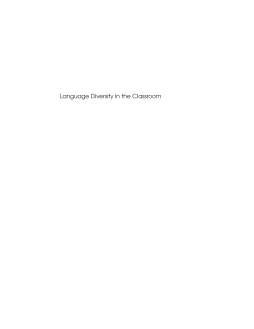
Additional Information
Book Details
Abstract
This book provides comprehensive coverage of language contact in classroom settings. A thorough analysis of the sources and implications of social “disadvantage” is presented first, since the nonstandard dialects that children bring with them to school – and the unfavourable perceptions of these dialects – have traditionally given rise to educational difficulties. The persistence of these perceptions is particularly highlighted. More general issues surrounding the range and implications of language attitudes are dealt with, as is the important “test case” of Black English. The book also discusses foreign-language teaching and learning, as well as the assumptions and intentions underpinning bilingual and multicultural education. Given its breadth and its style, this book should be of interest and value to all teachers, as well as to students and researchers concerned with any aspect of the social life of language.
The author claims-quite rightly-that this is a "comprehensive and jargon free" survey of those linguistic issues which have educational components or ramifications. It is both a scholarly and brave piece of work, since Edwards does not hesitate to attack certain 'politically correct' approaches to the topic, where these can be shown to render no service to the groups referred to; he also attacks the use of inflated language, unproven statements along with the use of theories inappropriate to the subject (discourse analysis comes out particularly badly in this respect).
Anne Judge, University of Surrey
The rapidly changing demographic composition of students in American (& other) schools poses an increasing challenge for teachers who increasingly are finding larger and larger numbers of students from diverse ethnolinguistic and racial backgrounds in their classes. School systems are beginning to understand the need to better prepare their teachers to understand and to draw upon the linguistic resources that students bring to the classroom. Language Diversity in the Classroom is an excellent book that should inform and stimulate discussion in teacher education programs. I recommend it enthusiastically.
G. Richard Tucker, Paul Mellon University Professor of Applied Linguistics, Carnegie Mellon University
John Edwards has written a plethora of outstanding journal articles, and several exceptional books-my favourite, to date, being his wonderful "Multilingualism"(1994). This has now changed: "Language and Diversity in the classroom" is my new favourite, and I am delighted to recommend it most highly.
Timothy Reagan, Central Connecticut State University
John Edwards is a Professor of Psychology at St Francis Xavier University. His research interests are in language, identity and the many ramifications of their relationship. He has lectured and presented papers on this topic in some thirty countries. Professor Edwards is the editor of the Journal of Multilingual and Multicultural Development. He is the author of several books including Language and Identity (Cambridge, 2009) and Un mundo de lenguas (Aresta, 2009) as well as many articles, chapters and reviews.
This volume provides a comprehensive background on research on sociolinguistic and cultural variation in the classroom and the linguistic behavior of speakers of nonstandard dialects and foreign languages. Edward’s voice is distinct and his conviction is clear throughout the book. This volume is appropriate for in-service or preservice teachers; it is particularly relevant for training programs in language arts, second or foreign language teaching, and bilingual or multicultural education.
Gabriela G. Alfaraz, Michigan State University
Table of Contents
| Section Title | Page | Action | Price |
|---|---|---|---|
| Contents | v | ||
| Chapter 1 Introduction | 1 | ||
| Chapter 2 Discourse Analysis and its Discontents | 24 | ||
| Chapter 3 Disadvantage: A Brief Overview | 40 | ||
| Chapter 4 Disadvantage: The Genetic Case | 52 | ||
| Chapter 5 Disadvantage: The Environmental Case | 77 | ||
| Chapter 6 The Language Debate | 93 | ||
| Chapter 7 The Persistence of Linguistic Deficit | 126 | ||
| Chapter 8 Evaluative Reactions to the Language of Disadvantage | 146 | ||
| Chapter 9 Black English as Ebonics | 170 | ||
| Chapter 10 ‘Foreign’ Languages in the Classroom | 186 | ||
| Chapter 11 Multiculturalism and Multicultural Education | 206 | ||
| Chapter 12 Bilingualism: A Very Brief Overview | 234 | ||
| Chapter 13 Bilingual Education | 250 | ||
| Chapter 14 A Concluding Statement | 279 | ||
| References | 289 | ||
| Index | 335 |
